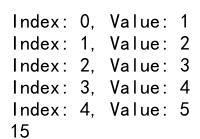JavaScript Reduce

在JavaScript中,reduce()是一个非常有用的数组方法,它可以将数组中的每个元素累加到一个最终值中。reduce()方法接受一个回调函数作为参数,这个回调函数可以接受四个参数:累加器(accumulator)、当前值(current value)、当前索引(current index)和数组本身(array)。在每次执行回调函数时,累加器的值会根据回调函数的返回值进行更新,最终返回一个单一的值。
基本用法
下面是一个简单的示例,演示了如何使用reduce()方法将数组中的所有元素相加:
const numbers = [1, 2, 3, 4, 5];
const sum = numbers.reduce((accumulator, currentValue) => {
return accumulator + currentValue;
}, 0);
console.log(sum); // 输出 15
代码运行结果:

在这个示例中,我们定义了一个包含5个数字的数组numbers,然后使用reduce()方法将这些数字相加,最终得到了总和15。
初始值
reduce()方法的第二个参数是可选的,它表示累加器的初始值。如果不提供初始值,reduce()方法会从数组的第一个元素开始累加,如果数组为空则会抛出一个错误。下面是一个示例,演示了如何使用初始值来计算数组中所有元素的乘积:
const numbers = [1, 2, 3, 4, 5];
const product = numbers.reduce((accumulator, currentValue) => {
return accumulator * currentValue;
}, 1);
console.log(product); // 输出 120
代码运行结果:

在这个示例中,我们提供了初始值1,然后使用reduce()方法计算了数组中所有元素的乘积,最终得到了120。
索引和数组参数
回调函数的第三个和第四个参数分别表示当前元素的索引和数组本身。这些参数是可选的,可以根据需要选择是否使用。下面是一个示例,演示了如何在回调函数中使用索引参数:
const numbers = [1, 2, 3, 4, 5];
const sumWithIndex = numbers.reduce((accumulator, currentValue, currentIndex) => {
console.log(`Index: {currentIndex}, Value:{currentValue}`);
return accumulator + currentValue;
}, 0);
console.log(sumWithIndex); // 输出 15
代码运行结果:

在这个示例中,我们在回调函数中打印了当前元素的索引和值,然后计算了数组中所有元素的总和。
使用箭头函数简化代码
在上面的示例中,我们使用了传统的匿名函数来定义回调函数。如果你喜欢使用箭头函数,也可以简化代码。下面是一个示例,演示了如何使用箭头函数来计算数组中所有元素的平方和:
const numbers = [1, 2, 3, 4, 5];
const squareSum = numbers.reduce((accumulator, currentValue) => accumulator + currentValue ** 2, 0);
console.log(squareSum); // 输出 55
代码运行结果:

在这个示例中,我们使用箭头函数来定义回调函数,计算了数组中所有元素的平方和,最终得到了55。
使用reduce()实现其他数组方法
除了累加操作,reduce()方法还可以实现其他数组方法,比如map()、filter()等。下面是一个示例,演示了如何使用reduce()方法实现map()方法:
const numbers = [1, 2, 3, 4, 5];
const doubledNumbers = numbers.reduce((accumulator, currentValue) => {
accumulator.push(currentValue * 2);
return accumulator;
}, []);
console.log(doubledNumbers); // 输出 [2, 4, 6, 8, 10]
代码运行结果:

在这个示例中,我们使用reduce()方法实现了map()方法,将数组中的每个元素都乘以2。
使用reduce()处理对象数组
reduce()方法不仅可以处理数字数组,还可以处理对象数组。下面是一个示例,演示了如何使用reduce()方法计算对象数组中某个属性的总和:
const products = [
{ name: 'iPhone', price: 999 },
{ name: 'iPad', price: 799 },
{ name: 'MacBook', price: 1299 }
];
const totalPrice = products.reduce((accumulator, currentValue) => accumulator + currentValue.price, 0);
console.log(totalPrice); // 输出 3097
代码运行结果:

在这个示例中,我们定义了一个包含产品对象的数组products,然后使用reduce()方法计算了所有产品的总价,最终得到了3097。
使用reduce()实现复杂逻辑
reduce()方法可以实现非常复杂的逻辑,比如嵌套循环、条件判断等。下面是一个示例,演示了如何使用reduce()方法实现一个简单的计算器,计算包含加法、减法和乘法的表达式:
const expression = ['+', 1, '*', 2, '-', 3, 4];
const result = expression.reduce((accumulator, currentValue, index, array) => {
if (currentValue === '+') {
return accumulator + array[index + 1];
} else if (currentValue === '-') {
return accumulator - array[index + 1];
} else if (currentValue === '*') {
return accumulator * array[index + 1];
} else {
return accumulator;
}
}, 0);
console.log(result); // 输出 5
代码运行结果:

在这个示例中,我们定义了一个包含加法、减法和乘法的表达式数组expression,然后使用reduce()方法实现了一个简单的计算器,最终得到了5。
处理空数组
如果数组为空,reduce()方法会抛出一个错误。为了避免这种情况,可以提供一个初始值,或者在回调函数中进行判断。下面是一个示例,演示了如何处理空数组的情况:
const emptyArray = [];
const sum = emptyArray.reduce((accumulator, currentValue) => accumulator + currentValue, 0);
console.log(sum); // 输出 0
代码运行结果:

在这个示例中,我们定义了一个空数组emptyArray,然后使用reduce()方法计算了数组中所有元素的总和,由于数组为空,最终得到了0。
使用reduce()实现数组去重
reduce()方法也可以用来实现数组去重的功能。下面是一个示例,演示了如何使用reduce()方法去除数组中的重复元素:
const numbers = [1, 2, 2, 3, 3, 4, 5, 5];
const uniqueNumbers = numbers.reduce((accumulator, currentValue) => {
if (!accumulator.includes(currentValue)) {
accumulator.push(currentValue);
}
return accumulator;
}, []);
console.log(uniqueNumbers); // 输出 [1, 2, 3, 4, 5]
代码运行结果:

在这个示例中,我们定义了一个包含重复元素的数组numbers,然继续输出:
然后使用reduce()方法去除了数组中的重复元素,最终得到了不重复的数组。
使用reduce()实现数组分组
reduce()方法还可以用来实现数组分组的功能。下面是一个示例,演示了如何使用reduce()方法将数组中的元素按照某个条件进行分组:
const numbers = [1, 2, 3, 4, 5, 6, 7, 8, 9, 10];
const groupedNumbers = numbers.reduce((accumulator, currentValue) => {
if (currentValue % 2 === 0) {
accumulator.even.push(currentValue);
} else {
accumulator.odd.push(currentValue);
}
return accumulator;
}, { even: [], odd: [] });
console.log(groupedNumbers); // 输出 { even: [2, 4, 6, 8, 10], odd: [1, 3, 5, 7, 9] }
代码运行结果:

在这个示例中,我们定义了一个包含数字的数组numbers,然后使用reduce()方法将数组中的偶数和奇数分别放入不同的数组中,最终得到了分组后的结果。
使用reduce()实现数组扁平化
reduce()方法还可以用来实现数组扁平化的功能,将多维数组转换为一维数组。下面是一个示例,演示了如何使用reduce()方法实现数组扁平化:
const nestedArray = [[1, 2], [3, 4], [5, 6]];
const flattenedArray = nestedArray.reduce((accumulator, currentValue) => accumulator.concat(currentValue), []);
console.log(flattenedArray); // 输出 [1, 2, 3, 4, 5, 6]
代码运行结果:

在这个示例中,我们定义了一个多维数组nestedArray,然后使用reduce()方法将多维数组转换为一维数组,最终得到了扁平化后的结果。
使用reduce()实现数组分割
reduce()方法还可以用来实现数组分割的功能,将数组按照指定的大小分割成多个子数组。下面是一个示例,演示了如何使用reduce()方法实现数组分割:
const numbers = [1, 2, 3, 4, 5, 6, 7, 8, 9, 10];
const chunkedArray = numbers.reduce((accumulator, currentValue) => {
if (accumulator[accumulator.length - 1].length < 3) {
accumulator[accumulator.length - 1].push(currentValue);
} else {
accumulator.push([currentValue]);
}
return accumulator;
}, [[]]);
console.log(chunkedArray); // 输出 [[1, 2, 3], [4, 5, 6], [7, 8, 9], [10]]
代码运行结果:

在这个示例中,我们定义了一个包含数字的数组numbers,然后使用reduce()方法将数组按照大小为3分割成多个子数组,最终得到了分割后的结果。
使用reduce()实现数组去除假值
reduce()方法还可以用来实现数组去除假值的功能,将数组中的假值(false、null、0、””、undefined、NaN)去除。下面是一个示例,演示了如何使用reduce()方法去除数组中的假值:
const values = [1, 0, false, '', 2, null, 3, undefined, 4, NaN, 5];
const truthyValues = values.reduce((accumulator, currentValue) => {
if (currentValue) {
accumulator.push(currentValue);
}
return accumulator;
}, []);
console.log(truthyValues); // 输出 [1, 2, 3, 4, 5]
代码运行结果:

在这个示例中,我们定义了一个包含假值的数组values,然后使用reduce()方法去除了数组中的假值,最终得到了只包含真值的数组。
通过以上示例,我们可以看到reduce()方法的强大之处,它不仅可以实现简单的累加操作,还可以实现复杂的逻辑,处理各种不同类型的数组。在实际开发中,合理地运用reduce()方法可以让代码更加简洁、高效。
 极客教程
极客教程